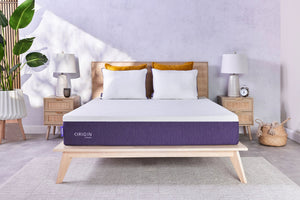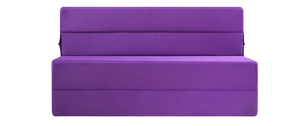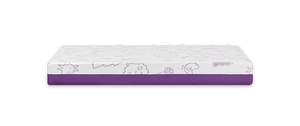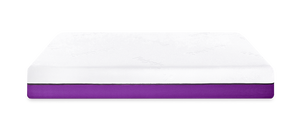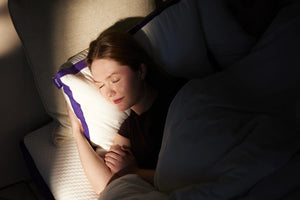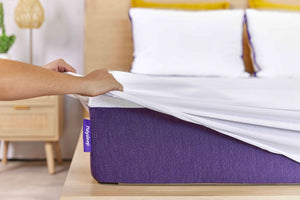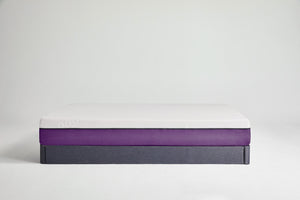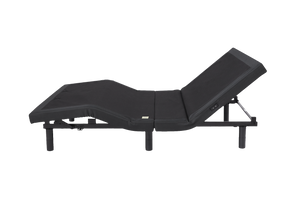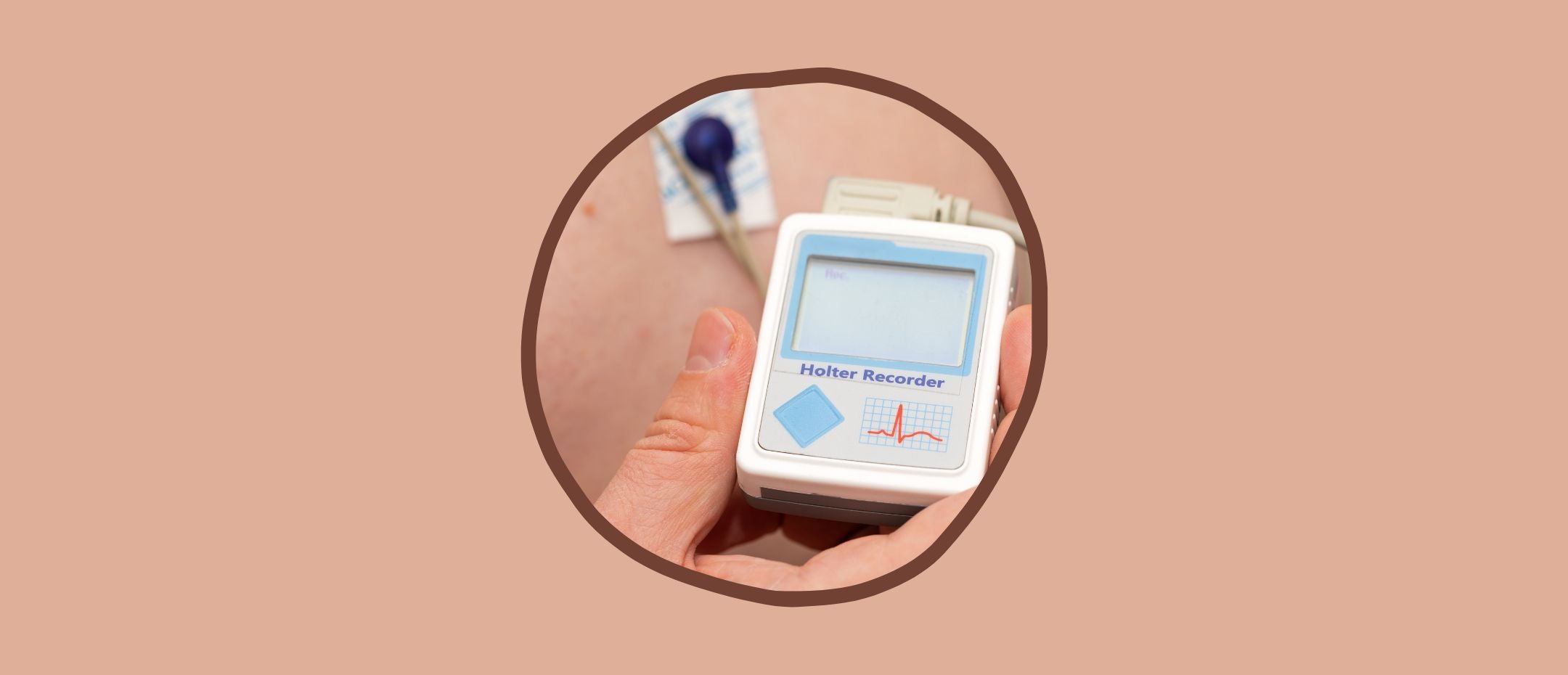Approximately 5 percent of the general population, or 1 in 18 people, report having an abnormal heart rhythm or arrhythmia.
An irregular heartbeat or cardiac rhythm can lead to various medical conditions depending on the severity of an abnormality.
Fortunately, there are many options to determine the presence of an abnormal rhythm, including getting an electrocardiogram and/or wearing a Holter monitor.
At Polysleep, we know that sleeping with a Holter monitor can be uncomfortable, but here are tips for sleeping with a Holter monitor.

What is a Holter monitor and what is its purpose?
Symptoms, including hypotension (low blood pressure), fainting, heart palpitations, dizziness, lightheadedness, and extreme tiredness (fatigue), should warrant a trip to your physician’s office.
During the appointment, your physician is likely to conduct an ECG test while you are at rest to evaluate how the heart is functioning.
When these results do not produce a definitive cause of symptoms, your physician may order continuous monitoring with a Holter monitor.
A Holter monitor is a small, wearable electrocardiogram device that continually monitors the functionality of your heart.
Unlike a traditional electrocardiogram performed in an office setting while at rest, a Holter monitor tracks the rhythm and rate of your heart during routine activities like a trip to the grocery store, work, light exercise, and sleep.
Why do you need a Holter monitor?
What is a Holter monitor used for? Continuous monitoring through a Holter monitor is used for many reasons. For instance, if you’ve experienced intermittent chest pain that was not recreated during your medical appointment or was not explained on a traditional electrocardiogram, then your physician may advise further testing with a Holter monitor.
The Holter monitor is indicated if you have unexplained symptoms related to the function of your heart to help identify the underlying cause of the arrhythmia.
It is also used in assessing the risk of Wolff-Parkinson-White syndrome and to determine if cardiac medications or implantable devices are working as intended.

What does a Holter monitor look like?
A Holter monitor is a non-invasive device that is placed on a patient’s chest in a physician’s office.
Placing this monitoring device does not require invasive procedural work. Men with a rather hairy chest will need to be shaved on the chest where the electrodes are placed.
This small recording device is approximately the size of a deck of standard playing cards. You can wear the device on a necklace where it hangs near the chest.
The electrodes placed strategically on the chest are connected to the device itself through small wires that transmit the information gathered.

What does a Holter monitor detect?
Primary care providers and physicians specializing in diseases of the heart utilize a Holter monitor for several things.
The most common use of a Holter monitor is to detect an abnormal heartbeat or heart rhythm that is not duplicated during a standard, at-rest electrocardiogram. The Holter monitor allows a cardiologist to view how the heart truly functions during activity and daily activities rather than just at rest.
A Holter monitor is often used to determine the underlying cause of various cardiac problems, including:
- Chest pain
- Dizziness or fainting
- Arrhythmia
- Palpitations

Holter monitoring devices are also used to determine how well the heart is being oxygenated, if prescription heart medications are working, and to determine if a pacemaker is functioning as it was intended.
Because this device is non-invasive, it requires no downtime or special care after placement. This means you can return to normal activities as soon as your appointment is completed.
A Holter monitor cannot get wet, so swimming, bathing, or showering is not permitted while wearing the device.
It is recommended to maintain a daily journal of activities, medications taken, and any symptoms you may experience as well as the date, time, and what you were doing when symptoms began.
A detailed log of activities while wearing the monitor can help your cardiologist piece together the cause.
Is sleeping with a Holter monitor okay?
A Holter monitor is often worn continuously for 24 to 48 hours to detect an abnormality, including during sleeping hours.
Many people find themselves questioning how to sleep with a Holter monitor in place and though it may seem difficult, it is not impossible.
The Holter monitor is a painless device that should not disrupt daily living. Experts recommend sleeping in a position of comfort while trying to forget the device is there.
When to sleep with a Holter monitor
Are you curious about when and how to sleep with a Holter monitor?
Unless otherwise directed by your prescribing physician, a Holter monitor should be worn at all times during monitoring and should not be removed - even for sleeping.
Remember, a Holter monitor provides continuous monitoring of the heart to detect abnormalities that can occur day or night, so it is imperative to wear the monitor throughout the entire duration.
Where should a Holter monitor be placed when sleeping?
Holter monitoring devices are designed to provide continuous monitoring of the heart for 24 to 48 hours, depending on the preference of your primary provider.
However, this leaves a patient to wonder where to place a Holter monitor while sleeping and can you sleep on your side with a Holter monitor?
As you get ready to climb into bed at night when wearing a Holter monitor, the most important thing to remember is to sleep in the manner you feel most comfortable.

As you sleep, the Holter monitor must remain close enough to you that the electrodes are not accidentally pulled off of your chest during the night.
Many people find sleeping on their side with the monitoring device placed beside their body works best.
Some stomach and back sleepers clip the Holter device to a t-shirt or the waistband of their pajamas.
Tips for sleeping with a Holter monitor
Sleeping with a Holter monitor can seem difficult as it may affect your normal position of comfort. Below are a few helpful tips for getting a good night’s rest without disrupting the monitoring process.
Wear a t-shirt to sleep
Whether you normally sleep with a shirt on or not, wearing a shirt can help to minimize the risk of an electrode being disconnected throughout the night.
Forget the device is there
Many people place too much focus on the device, creating worry, panic, and anxiety that they will accidentally disrupt the Holter monitor. The added stress can make sleep more difficult and result in overall poor sleep quality.
Take medication for sleep
Over-the-counter or prescription medication may help allow you to fall asleep despite the added fear accompanied by a Holter monitoring device. Remember, take note of any medications taken, including sleeping medication, to help your doctor better reach a conclusive result.
Best tips for a good night of sleep
Sleep is crucial in allowing the body to function as intended, as well as allowing the body to rest after a long day. There are many things you can do to help achieve a better nigt’s sleep including:
- Ensure your sleep space is free from artificial blue light emitted from electronic devices, including light from the television, a tablet, or cell phone.
- Utilize blackout curtains to remove outside light sources.
- Avoid caffeine or alcohol too close to bedtime as this can disrupt the brain’s ability to filter through the various stages of sleep.
- Upgrade your mattress to an antimicrobial memory foam mattress to ensure a safe, healthy, comfortable sleep space.
Frequently asked questions
What activities can you do with a Holter monitor?
There are minimal restrictions when wearing a Holter monitor. You may resume normal daily activities, including light exercise, work, and daily errands. You should, however, avoid swimming or bathing as the monitor cannot get wet.
What does a 24-hour Holter monitor show?
A Holter monitor assesses and analyzes the rhythm of the heart during your daily activities to evaluate the presence or risk of arrhythmia.
What does a Holter monitor measure?
The Holter monitor device measures electrical impulses of the heart to detect abnormalities.
How can I remove a Holter monitor?
This monitoring device should not be removed until testing has been completed. At that point, a medical professional will remove the device at the prescribing physician’s office.
Will a Holter monitor show palpitations?
Yes, a Holter monitor can detect heart palpitations experienced while the device is securely attached.
Can a Holter monitor detect sleep apnea?
A Holter monitor may predict the risk of sleep apnea due to cardiac events caught during monitoring, however, this device is not widely used to diagnose sleep apnea.
Takeaway
A good night of sleep allows crucial organs in the body to rest, relax, and prepare for the following day, but when health concerns arise sleep can be directly affected.
At Polysleep, we have curated an antimicrobial memory foam mattress designed with health and sleep comfort in mind.
More than 30 percent of our life is spent in bed. Therefore, your mattress should not only provide exceptional support and comfort, but it should also ensure your sleep space is healthy too.



